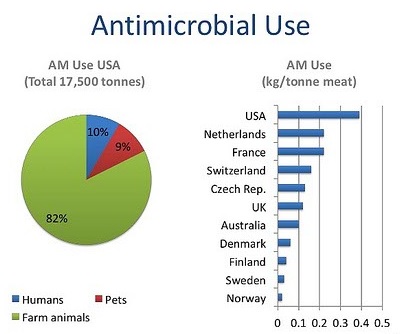There is an abundance of terrible science journalism out there. It usually takes the form of credulous hype that hails incremental advances as game-changing breakthroughs. Articles that are just plain misleading are more rare. And they are especially rare in quality outlets like the New York Times.
But rare is not the same as nonexistent. William Cohan’s article in the Times on antibiotic abuse in livestock feeding is incoherent and unsupported by data. In a word, it is crap journalism. I felt embarrassed to read it. Cohan and the Times should feel embarrassed to have published it.
Cohan’s central claims are that 1) antibiotics are prevalent in our meat supply and 2) they disrupt the gut microbiome leading to 3) a host of health disorders. None of these claims are unreasonable, but none of them are supported. Speculation masquerading as authority is bullshit.
Let’s unpack this mess:
- Google “antibiotic levels in meat” and one of the first hits you find is a Michigan State University fact sheet describing the system for detecting antibiotics in meat in the US. A link there takes you to a 2010 USDA report on actual levels found. In that year, the Food Safety Inspection Service tested some 230,000 meat samples for 128 chemicals. About 1600 (0.8%) exceeded allowable levels of antibiotics. Another 4200 (2.0%) tested positive but below allowable levels. Veal accounts for over half of all positives. So your chance of eating a hamburger with detectable antibiotic residues in it is about 1%. It took me five minutes to find this information. Cohan apparently couldn’t be bothered.
- OK, so even if only a few percent of meat supply is contaminated with antibiotics, poisoning a few percent of the population on a regular basis is not acceptable. So how likely is it that antibiotic levels in contaminated meats are high enough to disrupt the microbiome or have other health effects? The allowable level of tetracyclines in muscle meat is 2 ppm, roughly 2 µg/g. Eating a half-pound (230g) hamburger would give you a dose of 0.5 mg of tetracycline. Is that enough to do anything? Not medically it isn’t. A typical dose regimen for oral tetracycline is 500 mgs twice per day for seven days. The contaminated burger you ate (assuming all the tetracycline survived cooking) amounts to 1/1000th the dose you’d get from a single pill. It’s not crazy to think that micro levels of antibiotics have subtle effects on the microbiome, although there’s zero evidence that it does. But why bother to do the math when you can just assume your conclusion?
- There’s no question that clinical levels of antibiotics disrupt the gut microbiome. However, the evidence that these disruptions lead to metabolic and auto-immune disorders is suggestive, not dispositive. Antibiotic use, particularly early in life, is correlated with increased risk of Type 1 and Type 2 diabetes, weight gain, asthma, arthritis, and depression, not to mention antibiotic-resistant infections. But these are correlations – no one has been giving antibiotics to otherwise healthy children in order to determine if they are at risk for disease later in life. The people who got antibiotics (with the exception of a 1955 Navy study) were ill. Logically, it’s just as plausible that illness and infections were responsible for later health effects. Animal studies suggest that antibiotics can indeed increase risk of metabolic and other disorders. I’d say that the balance of evidence supports the hypothesis, and that it is imprudent to ingest antibiotics absent clear medical need. Still, we are far from certain that antibiotics – particularly at micro levels – cause any metabolic or auto-immune disorders. By “we”, I mean people who care about evidence, a group that does not include William Cohan.
There are many good reasons to oppose the routine dosing of animals with antibiotics. It promotes the selection of resistant organisms in the soil, which can then transfer resistance to human pathogens. It contaminates waterways, resulting in greater exposure than from eating meat. It enables abusive factory-farming practices. It is not even necessary to produce affordable meat, as Denmark and other countries have shown. Those would all be great stories for the Times to report.

From Antimicrobial Resistance (AMR)
Instead it chose to publish Cohan’s fact-free brain farts. He may be – and almost certainly is – right in his conclusions. But being right is no excuse for being lazy. I call bullshit.

Drew,
Well done….and I am in total agreement w.r.t. the 25th May Choen/NYT atricle. A basic white paper assessment of worse-case component clearance of active compounds from dosing the animal all the way through to exposure in the midgut of a human (should) produce a dose way below what would be considered therapeutic and ALSO well below everything I have seen as a dose that could promote selective pressure for resistance of even the most STABLE and potent antibiotics (anthracyckines, tetracyclines, cyclic lipopeptides)….say ~10ug/L. These things are “testable” ….difficult and expensive (under protocol) ….but why not do the real work before one publishes a claim? I guess because it s the NYT, they have no research budget of course, and need to publish.
The bigger concern here is that this article will
Be cited, and cited again….same as true Peer-reviewed paper.
Thanks again
Mike